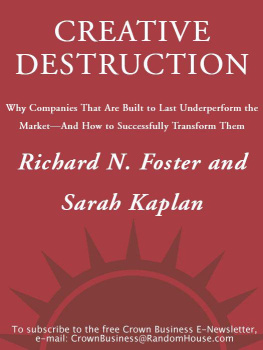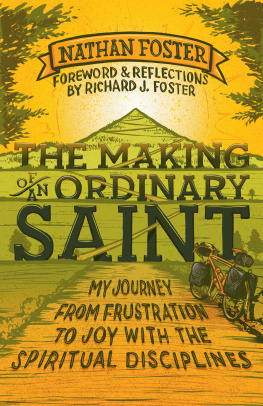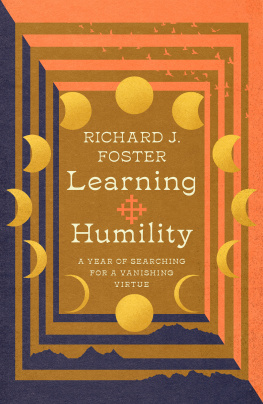Richard Foster - Creative Destruction
Here you can read online Richard Foster - Creative Destruction full text of the book (entire story) in english for free. Download pdf and epub, get meaning, cover and reviews about this ebook. year: 2011, publisher: The Crown Publishing Group, genre: Business. Description of the work, (preface) as well as reviews are available. Best literature library LitArk.com created for fans of good reading and offers a wide selection of genres:
Romance novel
Science fiction
Adventure
Detective
Science
History
Home and family
Prose
Art
Politics
Computer
Non-fiction
Religion
Business
Children
Humor
Choose a favorite category and find really read worthwhile books. Enjoy immersion in the world of imagination, feel the emotions of the characters or learn something new for yourself, make an fascinating discovery.

- Book:Creative Destruction
- Author:
- Publisher:The Crown Publishing Group
- Genre:
- Year:2011
- Rating:3 / 5
- Favourites:Add to favourites
- Your mark:
- 60
- 1
- 2
- 3
- 4
- 5
Creative Destruction: summary, description and annotation
We offer to read an annotation, description, summary or preface (depends on what the author of the book "Creative Destruction" wrote himself). If you haven't found the necessary information about the book — write in the comments, we will try to find it.
Richard Foster: author's other books
Who wrote Creative Destruction? Find out the surname, the name of the author of the book and a list of all author's works by series.
Creative Destruction — read online for free the complete book (whole text) full work
Below is the text of the book, divided by pages. System saving the place of the last page read, allows you to conveniently read the book "Creative Destruction" online for free, without having to search again every time where you left off. Put a bookmark, and you can go to the page where you finished reading at any time.
Font size:
Interval:
Bookmark:
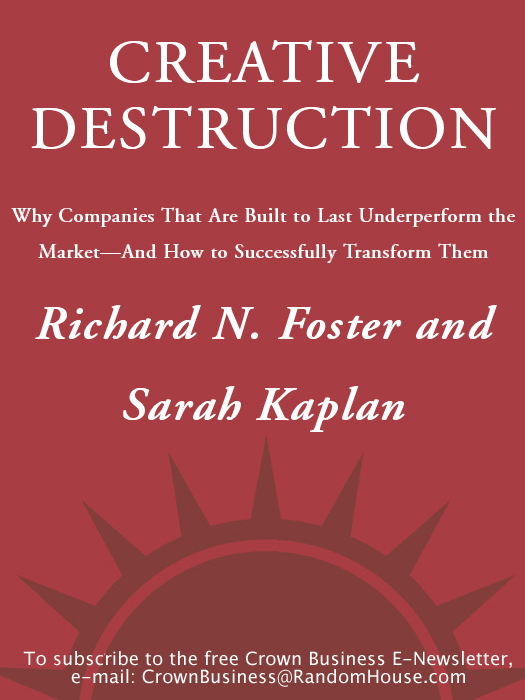
More Praise for Creative Destruction
In the tradition of Beat the Market and A Random Walk Down Wall Street, Creative Destruction blows holes in the conventional wisdom about management, corporate cultures, and the underpinnings of a successful corporation. It argues a whole new paradigm for survival and growth which hopefully will have a far-reaching effect on the actions of boards, management, and investors going forward. Foster and Kaplan are on to something profound.
Frank Biondi, Senior Managing Director, Waterview Advisors, Former Chairman and CEO of Universal Studios, and President and CEO of Vicacom
A provocative wake-up call for leaders.
Mike Masin, Vice Chairman and President, Verizon
As this book with its long-term analysis makes clear: A successful past is but an opportunity to build the future. The only true winners are those that relentlessly drive innovation and change and continually challenge organizational practices and culture.
Linda Robinson, Vice Chairman, Young and Rubicam
A compelling road map for management to strike a necessary balance between operational excellence and creative destruction. Those who do not heed its advice to challenge conventional mind-sets aggressively do so at their peril.
John Hagel, co-author of Net Worth and Net Gain:Expanding Markets Through Virtual Communities
Offers a clear blueprint for how corporations can modify their thinking in order to remain competitive.
Pamela Thomas-Graham, Executive Vice President, NBC, President and CEO, CNBC.com
Reading Creative Destruction was like the scales were falling off my eyes. I had had a mental cataract operation.
Robert McKinney, former U.S. Ambassador to Switzerland
I spend a good deal of every week listening to business leaders and economists from around the world discuss their writings and experiences. This is the single most informative account of the eternal battle between managers and markets, and it explains with intellectual force and hard research why managers must prune their corporations in order to survive the remorselessness of the market.
Leslie H. Gelb, President, Council on Foreign Relations
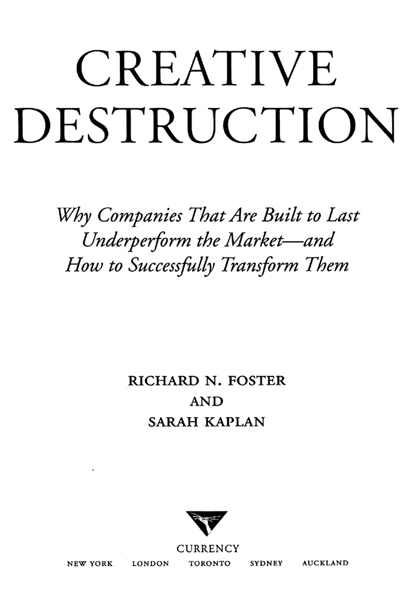
A CURRENCY BOOK
PUBLISHED BY DOUBLEDAY
a division of Random House, Inc.
CURRENCY is a trademark of Random House, Inc. and
DOUBLEDAY is a registered trademark of Random House, Inc.
Copyright 2001 by McKinsey & Company, Inc. United States
This book was originally published in hardcover by Currency in 2001
Library of Congress has cataloged the hardcover edition as:
Foster, Richard N.
Creative destruction : why companies that are built to last underperform the market, and how to successfully transform them / Richard Foster and Sarah Kaplan.
p. cm.
eISBN: 978-0-307-77931-1
1. Organizational change. 2. Strategic planning. 3. Technological innovationsManagement. I. Kaplan, Sarah, 1964. II. Title.
HD58.8.F687 2001
658.406dc21
00-065887
All Rights Reserved
All Trademarks are the property of their respective companies.
v3.1
To my youngest son, Thomas William Foster, for his energy, inquisitiveness, sparkle, and infinite patience; to my wife Catherine for her unending, unshakeable and enthusiastic support, confidence and patience; to my older sons: Doug for his market insight and practical understanding, and Lucien for his wisdom and counsel.
RNF
To my parents who set me on my path and to my sisters who have traveled with me along the way.
SK
Creative Destruction is the result of over a decade of research, sponsored by our colleagues at McKinsey & Co. and our clients. First and foremost, we would like to thank all of them for their support and counsel during this period.
While many colleagues have contributed time and thought to the arguments put forth in this book, some deserve special mention. First on the list is Peter Walker, the Managing Director of our New York Office. Pete has been a steady supporter of the effort since it earliest days. His path remained steady, even when it was not clear that we were still on the scent. Without his long-term support, this enterprise would not have succeeded.
As the work has moved along, others have played key roles in keeping the effort alive and the standards high. They include Rajat Gupta, Herb Henzler, Ian Davis, Bill Meehan, David Meen, John Bookout, Steve Coley, Mike Nevens, Bruce Roberson, Ron Hulme, Tim Koller, Bill Fallon, Ron Farmer, Peter Freedman, Anton von Rossum, Andreas Beroutsos, Eric Lamarre, Michael Silber, Jessica Hopfield, Endre Holen, Hugh Courtney, Kathleen Hogan, Bill Pade, Peter Bisson, Larry Kanarek, Suzanne Nimocks, and Kevin Coyne.
Several of our friends in academia have made strong and steady contributions to our thinking over the years. They include Tim Reufli from the University of Texas, David Campbell from the University of Illinois, Martin Shubik, Will Goetzmann, and Stan Garstka from Yale, Ronel Elul from Brown, Joe Bower, Clay Christensen and Teresa Amabile from Harvard Business School, Ron Heifetz from Harvards Kennedy School of Government and Mihalyi Csikszentmihalyi formerly of the University of Chicago (now at Claremont Graduate University).
Early readers and advisors included Brian Arthur and Eric Beinhocker, both of whom took enormous time to think through and comment on the strengths and weaknesses of our ideas.
Early McKinsey contributors to the effort included Karen Barth, Vince DePalma, Carl Hanson, Anna Slomovic, Bro Uttal, and Lily Zaidman. They helped in taking the earliest ideas and turning them into something tangible. Chip Hughes and Kenneth Bonheure conducted early explorations into the practical implications of our work as they turned our abstract ideas into useful tools for day-to-day life.
On the operating level, Shishir Shroff began working on the Performance Database that forms a critical part of our analysis while a graduate student at NYU Stern School of Business in the early 90s. Little did he suspect that the task might turn into a career, but it has. To this day, there is no one who understands more about the database and its construction than Shishir, who now is a Practice Specialist with our Corporate Finance and Strategy practice in our New York Office. In the early days Shishir worked under the guiding hands of Michael Allison and Mike Ghenta. Robin Tsai, one of the best statistical analysts that either of us ever have known, provided expert advice on what was knowable and what was not, along with insightful early statistical analyses. Later we had sustained contributions from Larry DiCapua, Tom Ball, and Ravi Chanmugam.
Ajay Shroff, now at Harvard Business School, undertook the job of rebuilding and updating the McKinsey Performance Database after the first efforts clearly showed that it would be valuable. Ajay brought enormous clarity to the effort. After the data were clearly portrayed, Christopher Baldwin and Robert Reffkin came on to write the key case studies which put a human face on the data. Their deep digging, unimpeachable standards for completeness, and strong writing skills will be seen in many chapters which follow. In the early days Anne Biondi provided expert bibliographic summaries and catalogs. Cara Davis provided continual facts for all phases of the books preparation, gave us expert literary advice, and found accurate answers and arcane facts to address our endless questions. Without Cara there would be no book.
Font size:
Interval:
Bookmark:
Similar books «Creative Destruction»
Look at similar books to Creative Destruction. We have selected literature similar in name and meaning in the hope of providing readers with more options to find new, interesting, not yet read works.
Discussion, reviews of the book Creative Destruction and just readers' own opinions. Leave your comments, write what you think about the work, its meaning or the main characters. Specify what exactly you liked and what you didn't like, and why you think so.

